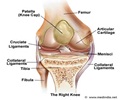A new study says that people with joint pain may be able to predict thunderstorms and summer downpours more accurately that some of the met forecasts.
Javad Parvizi, M.D., Ph.D., of the Rothman Institute at Thomas Jefferson University Hospital, said that people who have joint pain also have the ability to foretell rainstorms.He said that even though individuals can experience pain fluctuations with the slightest change in barometric pressure, most osteoarthritis patients report significant increases in pain before and during severe changes in weather, like summer downpours and thunderstorms.
"The phenomenon of people being able to forecast precipitation, especially rain, due to the level of their joint pain is real. It is not in the patient's head. There is science to back it up," said Parvizi.
Patients with osteoarthritis, rheumatoid arthritis, and other arthritic conditions usually experience weather-related joint pain. These conditions can affect any load-bearing joint, but is most common in hips, knees, elbows, shoulders and hands.
Animal joints contain sensory nerves called baro-receptors, which respond to changes in atmospheric pressure. These receptors especially react when there is low barometric pressure, implying that the atmosphere has gone from dry to moist, like when it is going to rain.
"When pressure in the environment changes, we know that the amount of fluid in the joint or the pressure inside the joint fluctuates with it. Individuals with arthritic joints feel these changes much more because they have less cartilage to provide cushioning," said Dr. Parvizi.
Advertisement
Other treatments may include non-steroidal anti-inflammatory drugs (NSAIDs), site-specific steroid injections, and long-term use of certain supplements like Omega-3 (which is used to reduce inflammation) and glucosamine and chondroitin, which have been shown, in combination, to significantly reduce arthritis pain and maintain healthy cartilage.
Advertisement
"Our goal is to get that painful little weatherman out of the patient's joints while treating the root cause of their condition," he said.
Source-ANI
RAS/L











